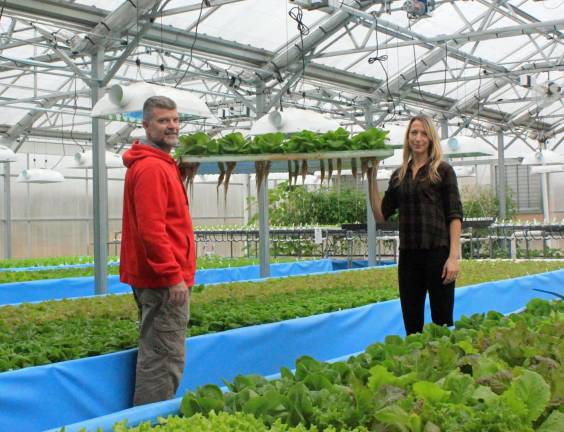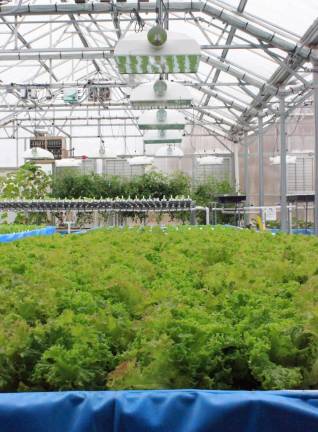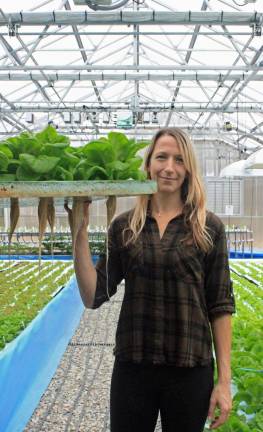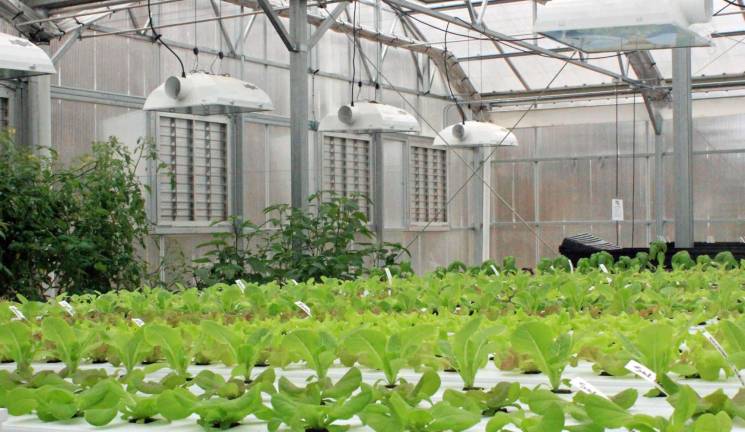Locally grown meets high tech




Aquaponics start-ups cultivate protein, greens and a chemical-free food system
By Alyssa Reaves
The greenhouse at Growing Free Farm looks like a small, unassuming garage. From the driveway, you’d never guess you were looking at a building that pumps out 100,000 pounds of food a year. The adjacent home, the only other building on this 15-acre property, shows no signs of life. Not yet, anyway. Owner Mike Keller and his business partner Maura Riordan have big, if still half-baked, plans. But for the moment, that’s not where the magic is happening.
I park and Riordan greets me, her beaming smile hinting at the passion behind this venture. We head into the greenhouse. Keller joins us inside. Not long ago, Riordan was a yoga teacher working as a part-time server at Keller’s nearby restaurant. Now the two are working side by side on a futuristic growing operation that’s smarter and cleaner than the factory farms that dominate agriculture now, leaving behind them a trail of Round-Up and glyphosate.
Growing vegetables and fish in one interconnected system is an ancient practice, but the technology in today’s primarily indoor aquaponics farms is anything but. Aquaponics is a hybrid between aquaculture, or fish farming, and hydroponics, or soilless plant growing. The fish waste provides the fertilizer for the plants, and the plants in turn filter the water, so the system doesn’t rely on fertilizers or chemicals of any kind. The closed loop, zero waste water system makes it one of the most efficient food growing systems there is. The climate-controlled set-up is what gives aquaponic growers their edge: the ability to produce micro greens and lettuce in January, when you’d struggle to find anything comparably fresh in even a specialty grocery store.
Riordan points out the brain of the operation, a rectangular, greyish box attached to the back wall. This is the Wadsworth computer system, the kind used in university greenhouses, botanical gardens and increasingly in large-scale marijuana grow operations. We are inside a room separated from the plants and fish by an additional wall - a biosecurity measure. Before stepping through the second door, we sanitize our hands, wiping our feet thoroughly on a pathogen-killing mat. Germaphobes they’re not; since they don’t use chemicals to kill pests, they don’t want any waltzing in the door in the indent of a shoe sole. And there will be more foot traffic here than at most farms, since part of Growing Free’s mission includes opening its doors to the public. They offer weekly tours at $10 person. That empty home? They envision an educational center there, maybe for cooking classes.
“It’s about feeding, educating, connecting with people,” Riordan said. “Every moment we choose something is a vote towards what we want for our future, for our body. So every decision, what we choose to purchase, is that vote.”
In the greenhouse, six 500-gallon tanks house tilapia in different stages of growth, flanked by two smaller tanks that comprise the fish nursery. These spiky-finned evolutionary warriors — which got a shout-out in the bible — are tropical fish, so they like it hot. Giant fans at the rear of the building and a window in front operate on the computer’s command. Weather stations inside and out are in constant communication, and let the system know if conditions fall outside the sweet spot. When that happens, the system will self-adjust, turning the heat down or the lights up. Aquaponics gives farmers the ability to create a utopian environment with the touch of a finger. “Temperature, humidity, pH, water temp, we just assist in all these variables,” Keller says over the whir of machinery. Given the increasingly volatile weather these days it is no little thing to be able, at least within these walls, to play God.
But it’s a risky business, too. It must be, given the track record of other aquaponic and fish farms that have set up shop in the region, only to go belly-up (sorry) within a few years. Two other that Dirt featured in the spring of 2012 — Continental Organics in New Windsor, NY and Local Ocean in Hudson, NY — were both brimming with fish and optimism. A year later, Local Ocean, an Israeli-owned saltwater fish farm, was a ghost town, the 1.5 million fish gone and the property foreclosed upon. In 2016, Continental Organics, a $5.2 million aquaponic farm that growing tilapia and greens and was supposed to employ 120 people, was accused of fraud by two building companies that worked on the construction, and the owner filed for bankruptcy.
Why do so many start-ups fail? Up front technology costs are a major factor, along with the people with PhD’s you often need to run it, said Yemi Amu, owner of six-year-old Oko Farms in Brooklyn and a regional authority on aquaponic farming. On the other side of the balance sheet, there’s only so much you can sell a tomato for.
The technology at Growing Free was not cheap. Though he declined to give specifics, Keller said the initial investment ran into the hundreds of thousands of dollars. But thanks to Keller’s construction background, they have the tools to address problems, whether structural or technical in nature - no doctoral degrees required.
The operation was born in 2016, when Keller sold his construction business. He always knew he wanted to bring healthy food to the community. “We can’t just be this commercial-based society that’s more, more more,” he said. But the roadblocks to farming - expensive land, short growing seasons and limited crop options - made him look at aquaponics. Growing vegetables alongside a protein seemed a smart combination.
Keller broke ground on the property he purchased in 2013; he had simultaneously purchased the Glen Gardner Tavern a mile away, renaming it Humphrey’s Tavern after a previous owner.
That’s where me met Riordan. A yoga teacher looking for extra income, she was serving at Humphrey’s part time, and had started a yoga series there. When Keller approached her about working with him to build the farm, she jumped at the chance. Riordan is new to farming, but only sort of. She grew up in a Pennsylvania farming community, watching her family tend their large vegetable and herb garden, and during college she sold produce at farmers markets. The two underwent a weeklong crash course in Wisconsin. They cared for the fish, took apart equipment, and learned the science behind the system. “We walked out of there really ready,” said Keller.
Back in New Jersey, Keller began the work that would take him a year and a half. His construction experience has proved invaluable: when something breaks, he can fix it - usually. When they encounter tech problems outside Keller’s wheelhouse, they call the Wisconsin aquaponics company.
Initially, the farm and restaurant were part of a joint vision, and the greens grown in this greenhouse do appear in Humphrey’s Bibb salad and quinoa wraps. But in two short years, each enterprise has taken on a life of its own.
Come January, 250 tilapia a month will be harvested and sold locally, to area restaurants and the community, via in-store pick up. In December, microgreens and four types of lettuce were available for order on their website, with two types of basil coming soon. At $18 for eight ounces, the return on microgreens beats just about any other legal crop. They cost as much by weight as breast milk, which is called “liquid gold” for the price it fetches online.
Although much of the operation is computer-controlled, plenty requires hands-on attention, like the 144 heads of lettuce that have to be harvested daily. Rows of greens must be rotated; the fish waste (a.k.a. poop) emptied daily into a filtration system that composts it and turns it into a clay bed, where tomatoes, cucumbers and other vegetables grow. It’s a “beautiful routine of moving things along” Riordan says, a process she finds subtly reminiscent of her yoga teaching.
The duo have been experimenting, producing veggies like bok choy and peppers. “A constant tweaking and experimenting,” Riordan says, is key to growth, not to mention staying in business.
Yemi Amu, the owner of Brooklyn’s Oko Farms, agrees. “If aquaponics is going to be viable and something that people take seriously, especially if you’re talking about water conservation, then we need to be able to grow more than just lettuce,” she said. Amu emigrated from Nigeria as a teenager and started Oko Farms in Brooklyn in 2012, making it one of the most well established aquaponics farms around. In the past year, her farm has produced more than a dozen different edibles, including catfish and prawns, amaranth and rice. An out-of-the-box thinker, Amu expresses something akin to joy over the “possibilities of grains.”
Oko Farms also plans to offer cooking classes in the near future. “I just love the idea of a farm also being a community center, where we’re learning about wellness and nutrition.” For Amu, raising community awareness also means providing access, which is why hers is one of the few outdoor aquaponics farms. She’s skeptical of the indoor farming model. “I strongly believe that part of my work as a farmer is also to be an environmental steward, and I cannot do that indoors. Because it’s not just about growing food, it’s also working with nature.”
Plenty of people like Amu consider a connection with the outdoors intrinsic to the soul of farming. Although the USDA’s organic certification recently embraced soilless farming, the more stringent standards set out by the farmer-led Real Organic Project exclude it. Sound soil stewardship, the group explains, is the fundamental basis of organic farming.
Though they may not have dirt under their nails, Riordan and Keller do see themselves as environmental stewards. They consider themselves “beyond organic.” Though they are not certified organic, they use non-GMO plant seeds and their fish eat non-GMO fish feed. They use no chemicals, relying on integrated pest management — bringing in specialized bugs that eat other bugs.
“We’re facilitators,” explains Keller. This is what nature intended, as they see it. Here is a local ecosystem capitalizing on the symbiotic relationship between plants and animals to produce fresh, wholesome food for the community — streamlined with the help of a very smart computer.
Sidebar: We need more fish
The American appetite for the other-other white meat has grown leaps and bounds in past decades. The 2011 governmental dietary guidelines upped the recommended intake of seafood to eight ounces or more a week to avoid keeling over from a heart attack, and we’re getting the message. In 2015 Americans added nearly an extra pound of seafood to our diets, according the Fisheries of the United States report by the National Oceanic and Atmospheric Administration, continuing a three-year rise. But at 15 pounds a year we’re still eating only half the recommended amount, and paying for it. A Harvard study found that low intake of omega-3 fatty acids from fish is the second-biggest dietary contributor to preventable deaths in the U.S.
Globally, aquaculture, which some call the single most viable solution to meet the world’s growing protein demand, has been growing faster than any other form of food production. It now supplies about half of the seafood humans eat.
But the U.S. hasn’t kept pace. At the same time as our consumption has gone up, our seafood supply has dwindled. There’s not enough for everyone to actually eat their recommended two servings a week, according to a 2016 USDA report. And most of what we do have is coming from the other side of the planet. We’re one of the world’s biggest importers of seafood, sending billions overseas, mostly to China. The National Oceanic and Atmospheric Administration, part of the U.S. Department of Commerce, in 2007 set a goal to increase U.S. aquaculture more than five-fold by 2025.
Aside from being good for the gross domestic product, growing fish locally instead of importing it would mean fewer food miles, fresher fish and stricter oversights (China, the giant in the fish farming industry, has been fingered for such misdeeds as feeding fish human waste, mislabeling fish and adding banned chemicals). The right model has to grow tasty, reasonably priced fresh fish. But that’s not enough anymore.
The public is waking up to the fact that fish are not necessarily a renewable resource – and seems to care. “Consumers of fish, particularly in the world’s richer economies, are increasingly demanding that retailers guarantee that the fish they offer is not only of high quality and safe to eat,” says the U.N. report on fisheries, “but also that it derives from fisheries that are sustainable.”